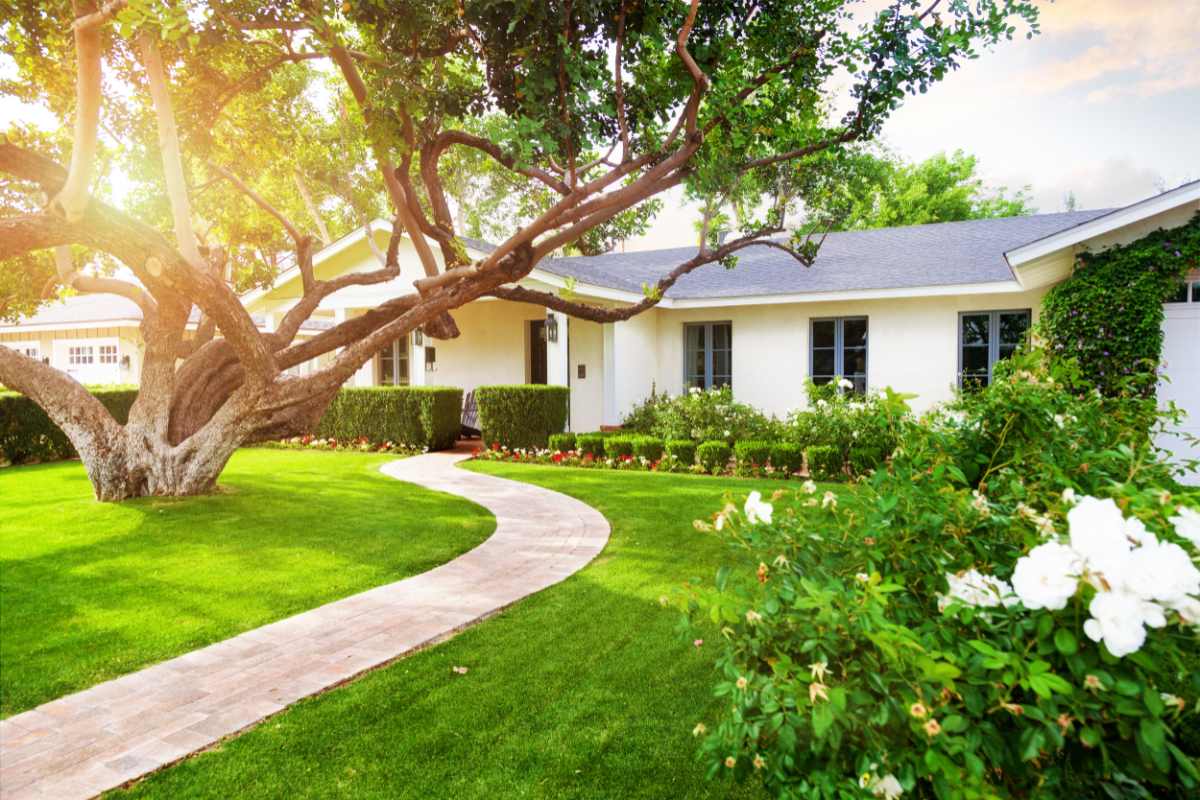
Stumped for ways to make the most of your crepe myrtle, peach, or bottlebrush tree? With the right landscaping design, large trees can help grow a secret garden, add charming curb appeal, and even make the perfect resting spot. In this article, we’ll explain the best 9 ways to landscape around trees.
From working with (or around) the shade, exposed roots, and falling leaves that trees add to your lawn, we’ll provide you the tools to use these elements as a way to enhance your outdoor space instead of hindering it.
1. Grow a Shade Garden
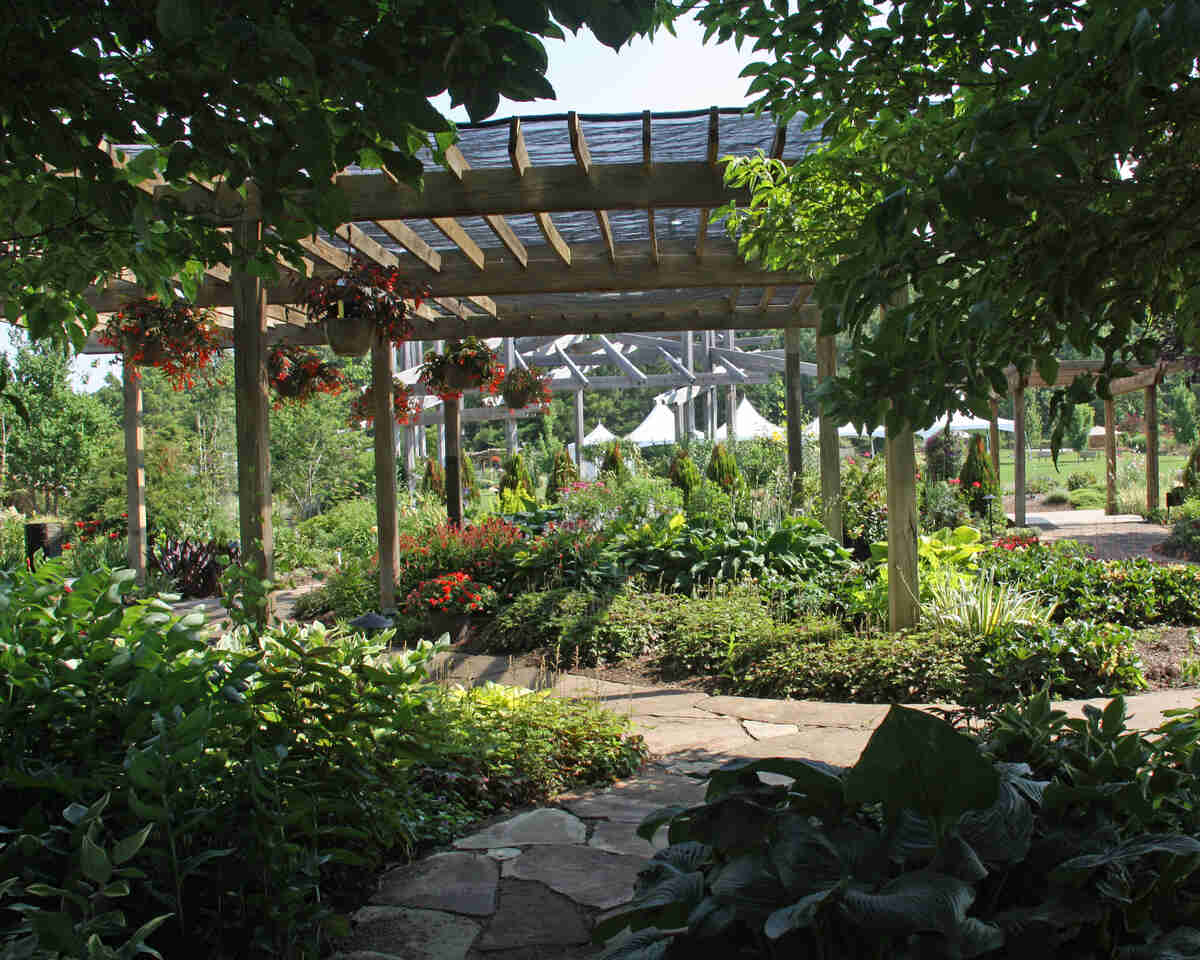
You may have once avoided sprucing up your tree’s trunk with beautiful plant material like annuals and perennials because you thought the shade would ruin all your hard work. But get those gloves on, and those trowels out because there are plenty of shade garden plants that will love the space beneath your tree.
These are a few of the best shade-loving plants to install in a shade garden:
- Coleus
- Coral bells
- Hosta
- Impatiens
After dressing your trees up with a gorgeous garden space, consider creating a garden path that guides you through the garden.
A path makes your shade garden much more accessible, and it also invites visitors to take a closer look without stepping on your new plants.
Tip: When landscaping around a tree, homeowners in the U.S. Northeast typically use ground covers like ivy or pachysandra. These shade-loving plants are planted in a 6-foot diameter circle around the tree’s trunk. This not only eliminates the need for mulch but also provides a natural delineation distinguishing the lawn from the tree trunk area.
2. Just Add Mulch
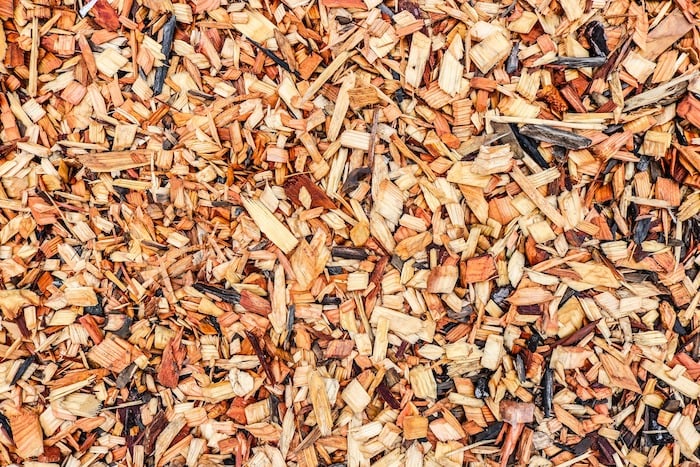
A layer of mulch covers exposed roots and adds a splash of color at the base of your mature trees. What color? What type of mulch? That is all up to you.
If you plant crocuses or other flowers in the mulch around your tree, you’ll have bursts of color in springtime. Or stick with hostas for some green amid the brown or other-colored mulch beneath the green of your tree. Mulch is one of the easiest and least expensive ways to add a pop of color and style around your trees.
Pro Tip: Avoid a mulch volcano around your tree. Keep mulch about 6 inches away from the base of the tree, and layer it no more than 2-3 inches thick. This will allow the roots to maintain good oxygen exchange with the soil. It will also prevent cracking along the bottom of the trunk, which can lead to insect, rodent, and disease problems.
3. Plant Some Flowers
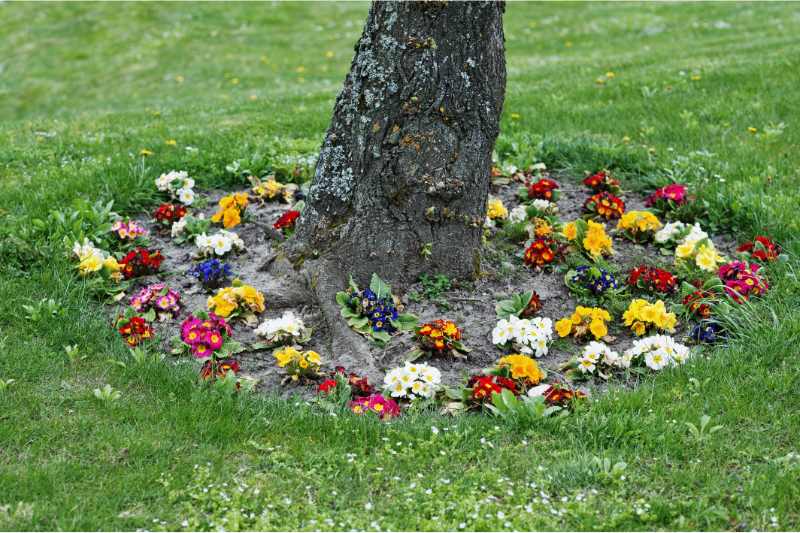
Your tree doesn’t have to stand alone in your yard. Flowers add some company to your tree. The pink, purple, or red petunias or yellow daffodils planted in the partial shade underneath all those branches will draw your and visitors’ eyes.
If you really want to go crazy, make your tree the focal and high point (literally) of a flower bed in your front yard or backyard. Check out 15 Shade Garden Ideas for ways to highlight the shade-loving plants in your yard.
4. Build a Retaining Wall
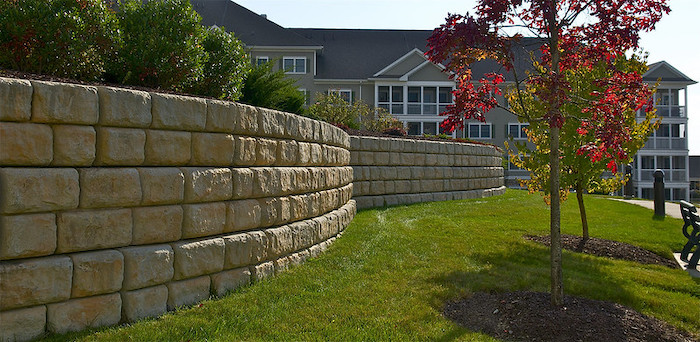
A retaining wall around your tree can add a uniform look to the yard and create a stunning focal point that boosts your curb appeal. Instead of bare roots and patchy grass at the base of a tree, a retaining wall made of pavers or stone will add great beauty and charm to your tree.
Retaining walls are also a creative solution to hilly terrain or erosion problems near your tree. However, retaining walls can be pricey.
5. Design a Deck or Patio Around the Tree
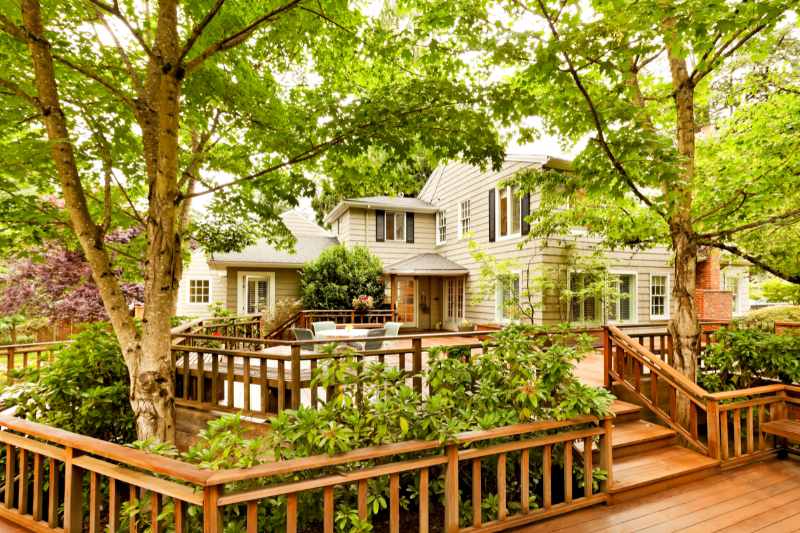
You’ve heard of trees growing inside homes, so why not have one grow through your outdoor living space? Building your patio or deck around a tree adds a significant dramatic effect, and your neighbors will be jealous they didn’t come up with the design first.
A tree growing right from your outdoor living space creates an even deeper connection with the environment as you lounge on a couch just 2 feet away from a giant plant. Not only will a tree on the deck or patio add excitement and serenity, but it will also provide excellent shade and coverage.
Keep in mind that a tree growing in your outdoor living space can be a high-maintenance landscape design. Trees often change shape as they grow, which may affect the area on your deck or patio.
Caution: If a tree’s trunk continues to grow, your deck’s boards may snap. Trees will also produce tree litter that needs cleaning and may make your wooden structure prone to termites.
6. Night Lighting
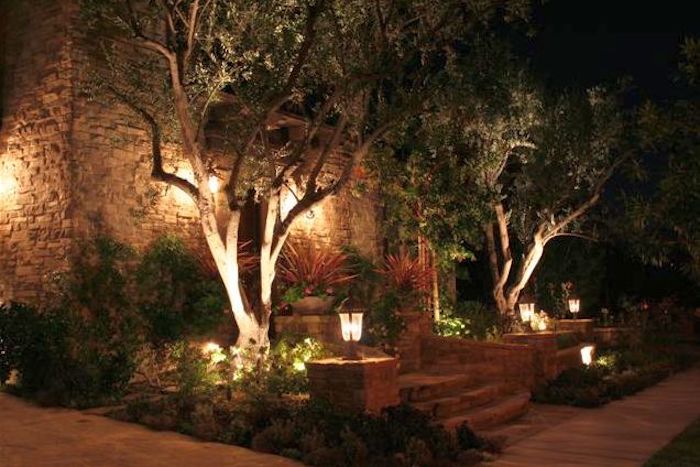
Homeowners, why let all your hard work disappear when the sun goes down? When designed right, outdoor landscape lighting can accentuate the design around your trees, highlight your home’s architecture, and even provide security when you need to step outside.
Landscape lighting around your trees is also a perfect way to set the mood. Are you looking forward to a relaxing dinner with friends? Get those appetizers ready, flip the switch, and invite everyone outside on the deck for a beautiful evening.
Have the surrounding trees light up the sky and turn off the lights near the door because who wants to worry about flying beetles getting in the house when company is over?
7. Create a Quiet Spot
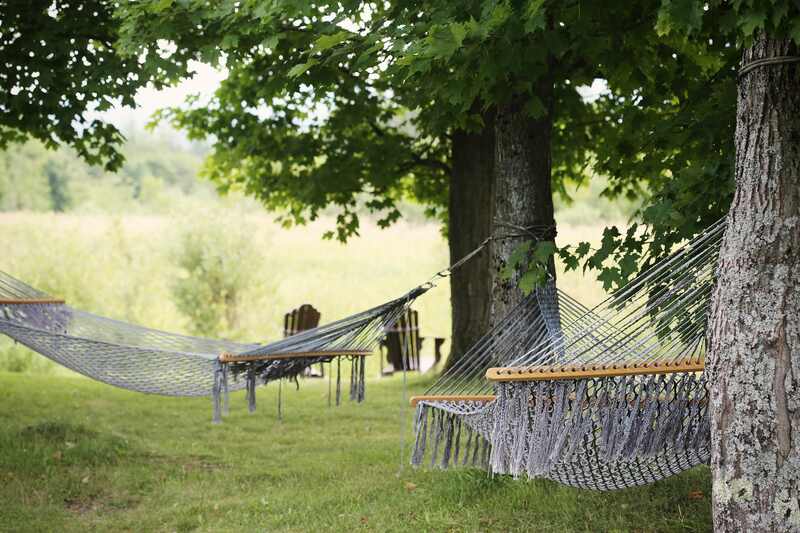
The cool shade beneath your tree makes it the perfect spot to set up a quiet space to read a book, enjoy a cup of tea, or write in a journal. You can turn this quiet space into a place entirely made for you.
Do you enjoy resting in a hammock, or do you prefer a comfortable seat on a bench? Would you enjoy a small water feature by your feet to put you in the perfect mood? What plants would you like to have near you as you relax under your tree and take in your outdoor space? Perhaps a birdbath to attract your avian friends to your lawn?
8. Plant a Succulent Garden

Though most succulents prefer sunlight, several hours of direct sunlight and scorching temperatures may burn these plants. Your tree plays a vital role in their growth by offering them a protective covering from too much sunshine and hot weather.
A succulent garden can add gorgeous texture and color to your landscape as these plants grow in a wide variety of shapes and sizes. Before getting your hands dirty and planting a succulent garden near your tree, it’s essential to know basic gardening tips for these plants.
9. Edging
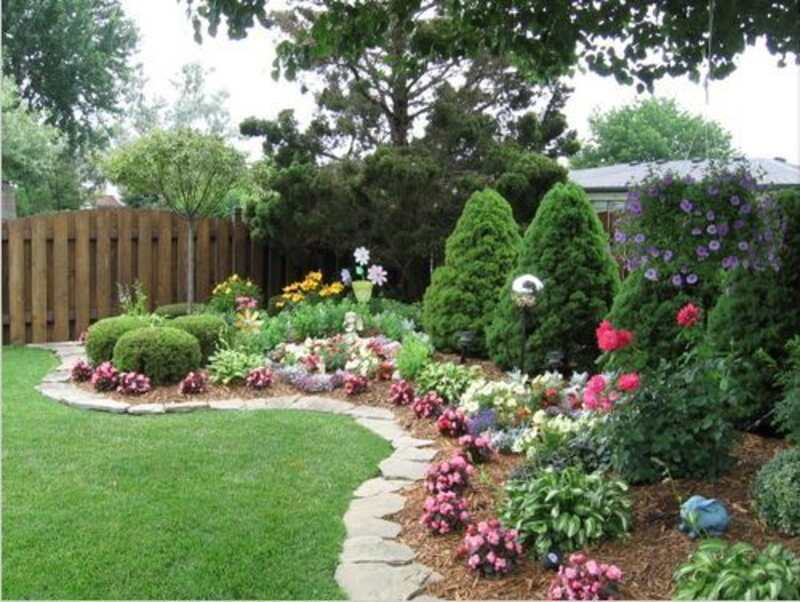
Edging is an excellent way to highlight specific areas of the lawn, hold in mulch, and keep any curious pets from digging around the tree’s roots.
If you want visitors to see your stunning oak tree, consider edging the tree’s base with small stones or bricks and adding layers of textured mulch. The mulch enhances the tree’s beauty and health, while the edging holds the mulch in place and makes the base of the tree pop.
Edging can also be a barrier to protect the roots from people, pets, and lawn mowers. Hedges can make an excellent barrier that accentuates the tree while also limiting access.
FAQs About Landscaping Around Trees
Are Exposed Roots Bad for My Tree?
Surfacing tree roots may make your tree vulnerable to the sharp blades of a mower. When equipment damages your tree roots, your tree becomes susceptible to disease due to open wounds.
Exposed roots may also prevent grass from growing, become a tripping hazard, and even lift structures.
How Can I Landscape Around a Tree With Exposed Roots?
Exposed tree roots pose many challenges for homeowners, including not being able to mow properly, tripping hazards, and no room for plant material. If you are looking for landscaping ideas around tree roots, consider mulch.
By creating a tree ring with mulch, you’ll not only be able to cover over your trees’ roots, but you can also eliminate the need for mowing in that area.
Piling on soil may seem like a great idea, but you’ll suffocate your tree this way. Like you, your tree’s roots need oxygen to breathe. Avoid adding a thick layer of soil, and stick with the mulch instead.
How Much Mulch Should Be Around a Tree?
The University of New Hampshire Cooperative Extension recommends spreading mulch in an even layer 2 to 3 inches deep around your tree. Do not layer more than 3 inches of mulch, as over-mulching can kill your tree.
The mulch should extend outward to at least the tree’s drip line, the circumference of the tree canopy where water drips onto the ground. Avoid piling the mulch against the tree trunk, as this encourages disease, insects, rodents, and root problems. Keep the mulch at least 6 inches or so away from the base of the trunk to allow good air circulation.
Can You Put Landscape Fabric Around Trees?
Some gardeners swear by landscape fabric, while others vow never to lay it on their lawns again. Those in favor of landscape fabric use it to prevent rock mulch from sinking into the soil, limit erosion, and reduce weeds.
Because trees don’t require any digging maintenance, gardeners prefer to use landscape fabric for trees rather than gardens or flower beds, where digging will often ruin the material. Organic mulches also require routine maintenance and replacements, whereas you can replace an inorganic mulch-like landscape fabric about once a year.
The cons of landscape fabric include decomposition gradually clogging the fabric’s drainage pores, a lack of biodiversity, and minimal organic materials. For healthier soil, when landscaping under trees, consider using an organic mulch like wood chips or shredded bark, which you can often find for free.
When to Call a Landscaping Pro
While many of these tree landscape ideas can be turned into fun DIY projects, hiring a landscape professional near you is a valuable option. Typically, they provide a free initial consultation.
During an initial consultation, not only will a landscape professional meet with you and discuss your tree landscaping ideas, but often, they will provide examples of their work.
The last thing you want to do is build a landscape design on your own and later find out that mismanaged curb appeal damaged your tree’s health.
Main Image Credit: Good Focused / Canva Pro / License